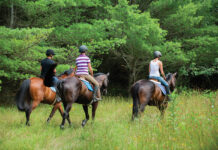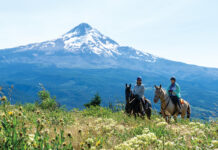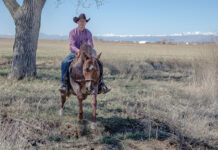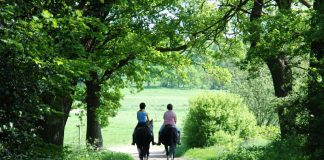
A favorite pastime of horse enthusiasts everywhere is trail riding. After all, what could be better than taking your horse for a ride through a beautiful, scenic landscape?
Unless you’re fortunate enough to own a lot of land that’s perfect for trail riding, chances are you’ll be riding on public or community trails that might not be exclusively for horseback riding. In this case, be sure to get permission from trail authorities before undertaking any trail maintenance, and see if you can coordinate a “trail maintenance weekend” with other users of the trail—with a group of people working together, the project will go much faster and smoother! To help you get started, here are some tips for maintaining trails in a way that is ideal for horseback riding…
Watch Out for Erosion
There may be no greater enemy to any trail than erosion, which can lead to a wide variety of issues, including mud and standing water. Unfortunately, erosion is often caused by poorly-planned trails that take a troublesome route through the landscape, which might not be something that you can change.
However, there are a few different ways to manage and control erosion. Adding gravel to wet areas where water tends to flow can be very helpful, as it creates a firmer, heavier surface that water is much less likely to wash away.

For particularly troublesome areas, you can even install man-made geosynthetic materials like geotextiles and geocells, which can greatly improve the strength and durability of erosion-prone soils, but they are expensive and complicated to install and may be too big an undertaking for someone that is not an expert in trail design.
Remove Fallen Trees from the Trail
It goes without saying that a fallen tree can be a nuisance on any trail, particularly one for horseback riding. The easiest approach might be to ride around a fallen tree by going off the trail, but this isn’t the best idea—riding off the trail area can cause erosion and lead to other issues with the trail. Instead of creating a detour around a fallen tree, cut it into logs with a chainsaw and move them out of the way to clear the original trail.
Prune Back Encroaching Tree Branches
If your trail system runs through a forest, then it’s inevitable that trees will encroach on the paths, sending their branches outward and narrowing the trail over time. Less obvious, but equally important, is overhead branches—as they grow longer, they can start to sag, dropping closer to the ground. This might not be noticed by hikers, but for people on horseback, it can be a significant issue.

Fortunately, keeping trees under control is relatively simple. Many branches can be pruned using nothing more than a good pair of pruning loppers or a handsaw, although for larger branches (or for extensive trail improving/maintenance), using a chainsaw with all appropriate safety gear can save time and effort.
For branches located high off the ground, a pole saw can help you reach them safely. You can also use a ladder, although this can be tricky and utmost care should be taken to avoid injury. For riding trails, be sure to clear the branches much higher than you would for a walking trail—a dozen feet should be plenty.
Trail maintenance requires time and effort, but the reward of a great riding trail is well worth it!






Our 4-H club works at keeping the horse trail clean, it is 10 miles, so now we have 4-wheelers with trailers to help.